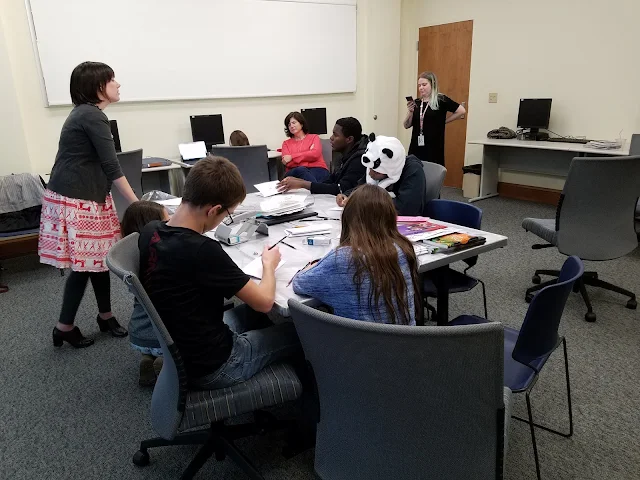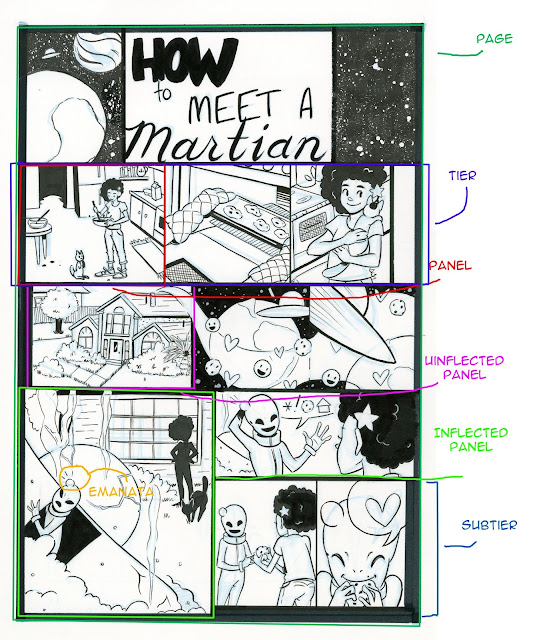Teaching Online Vs Teaching in Person
This isn't intended to be an in-depth post- teaching art, particularly as a freelance worker- can be complicated and nuanced, and would merit it's own series. Even then, I wouldn't necessarily feel comfortable sharing such a series as a How To, as I definitely still have much to learn.
I have a fair amount of experience teaching online and in person, and am always open to learning new techniques to improve my work and the viewer's experience.
** denotes personal experience teaching this kind of class
Teaching Online:
 |
| Screenshot from a recent Livestream workshop hosted on Youtube |
Written- blog post**
Written- zine
Youtube- standalone**
Youtube- livestreams**
Twitch Streams
Youtube Live
Instagram Live
Zoom class**
Zoom webinar
Recorded workshop**
Podcasts**
Google Hangouts On Air
Skillshare
Bluprint
Discord
Pros:
- Can do it from the comfort of your own home
- Don't need someone else's approval to start
- Online classes can really expand your reach and audience- you're not just tied to local students
- Easier to share digital resources
- Easier to record online events and share them than it is to record an inperson event and record it later
Cons:
- Need equipment that can handle recording, streaming, editing, photography
- Technical issues can destroy the entire workshop, rather than just acting as an obstacle
- Internet connectivity can make or break you, so people in rural areas (like South East Louisiana) may find themselves at a disadvantage (speaking from experience here)
- May not see consistent payment- or any payment at all
- Monetizing free resources is challenging
- Responsible for your own promotion
- Tied to the whims of the audience in terms of promotion and support- you REALLY need that positive word of mouth to grow
- Can be depression to never see the work your students make, or not have real time interactions with your students
- Students may not have access to the materials
- Difficult to keep people engaged
- Difficult to gauge how effective the material is
- Sometimes difficult to address and correct problems
- Online content is often taken for granted, and people don't value online content as much as they do physical, in person events
Teaching in Person:
 |
| Photo from one of my comic classes taught with St Charles Parish Library |
9-5 regular teaching position
Convention panels**
Convention Workshops**
Library workshops**
Classes through an art supply store**
Subcontracting under another art school**
Private tutoring
Meetup
Pros:
- PAYMENT! - Generally when you teach physical classes, payment is an expected part of the transaction. If payment isn't mentioned by your employer, make sure you mention what your rate is
- Working with students in person, in real time, allows you to get to know them as people, provides an opportunity for socialization, and allows you to give them real time feedback
- If you provide the materials, you can guarantee students have access to what you want them to use
Cons:
- Often responsible for providing all or most of the materials
- When working as a contract employee, responsible for the above, as well as creating lesson plans, activities- this takes up a lot of time that you may not see compensation for
- Often need someone willing to give you that first chance
- Transportation! Students often need to leave home to attend in person classes so a lack of public transportation, traffic issues, and lack of parking can severely hurt attendance
- Often need assistance
Notes on Teaching:
Promotion:For in person events, it's often easier to promote that event in person or using physical materials
- Fliers
- Mentioning events at other events
- Requesting students talk about it with friends
For online events, it's easier to promote that event online
- Utilize your social media accounts to talk about your classes
- Use hashtags to reach interested students outside your network
- Ask friends to share your posts
I've talked about promoting your in-person classes on a budget in my Promoting a Class or Workshop post.
Teaching online can be a great way to get some practice in teaching, and learning HOW to teach. Just because you're a skilled artist doesn't mean you're cut out for teaching- social skills, a genuine love for other people, and the ability to think critically and dissect process are all important both online and off.
If you're new to teaching in person, I would recommend NOT volunteering to teach classes free. This was a method I took when I was first starting out, and to my dismay, I was informed by several sources that they would only consider PAID classes as work experience. This was a frustrating misstep, as I'd offered my services free so I could build up a work history.
You may find it challenging to find someone willing to give you that first paid opportunity. Even with dozens of workshops under my belt (taught through conventions), two teaching internships, AND an MFA, I struggled to find an employer willing to work with me here in Nashville.
For example, I'd lived in Nashville FIVE YEARS, and consistently pitched classes and workshops, before finally convincing NCE to give me a shot. This first class- Making Comics and Zines, opened the door to other teaching venues such as Plaza and The Little Arthouse. However, it took five years of consistent pitching, and constantly mentioning that I teach comic classes to convince someone to give me that first chance here in Nashville. The takeaway here is PERSISTENCE.
Teaching online isn't a good fit for everyone. Personality is a huge part of online popularity, promotion, and even extends to classes and tutorials. You may have to work hard to find your niche online, and may find that it's not necessarily worth the time and distraction away from other projects. You have a LOT options when it comes to streaming, each with their own unique ecosystem, so it pays to do your research and watch a few examples to get a feel for what's right for you.
Online retention is a challenge, as users are spoiled for choice and entertainment. Music can help keep students engaged during online workshops and classes. I recommend doing your research and using Royalty Free and Creative Commons music during livestreams and as background music during tutorials. Actively engaging the chat, utilizing a facecam during streams, and using a mic are all great ways to stay connected during streamed events.
Programs like Zoom have their unique pros and cons. Zoom allows you to host a large audience AND interact with them. With a little savvy, you can control when students can interrupt the conversation, and students with webcams are able to show you their work. Unfortunately, Zoom streams have been hijacked a few times with illegal content, so you may want to be careful with how you promote Zoom streams.
More on Teaching Comics and Art:
Tips for Teaching Comics
Teaching Comics Professionally
Teaching a Comic Craft Module in Your Classroom
Materials for Teaching Comics Classes
In Defense of the Mini Comic
Promoting a Class or Workshop

Comments
Post a Comment